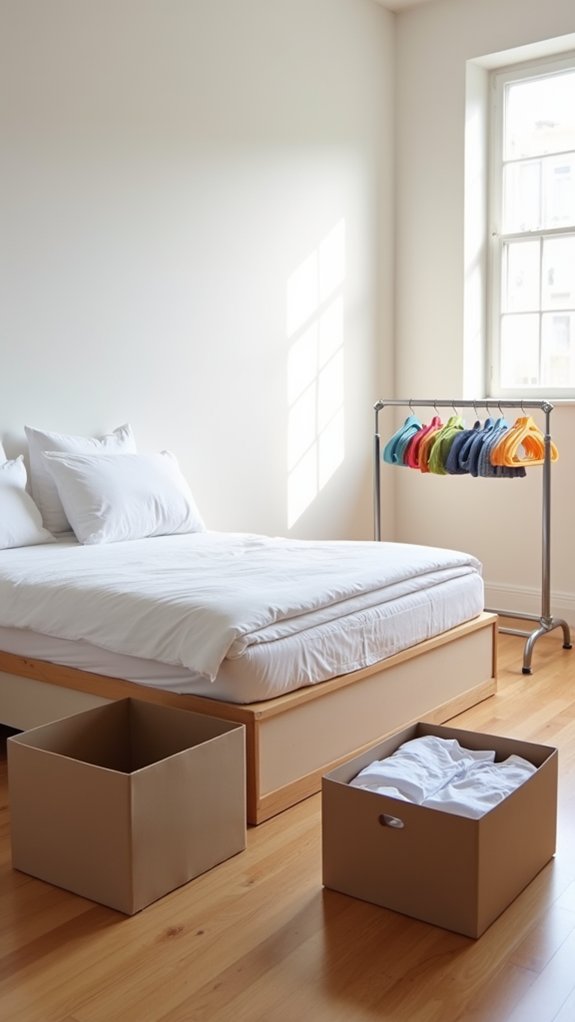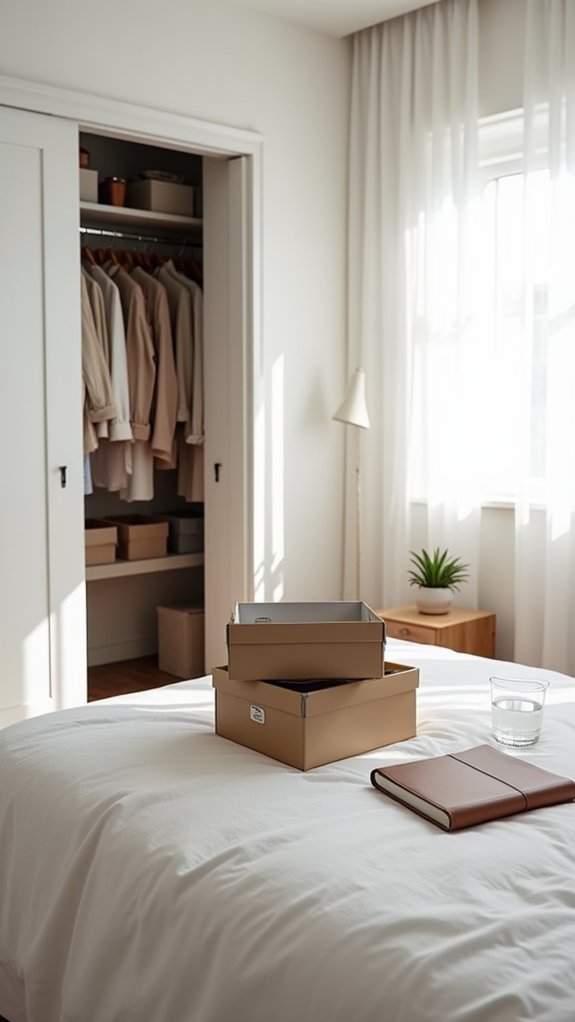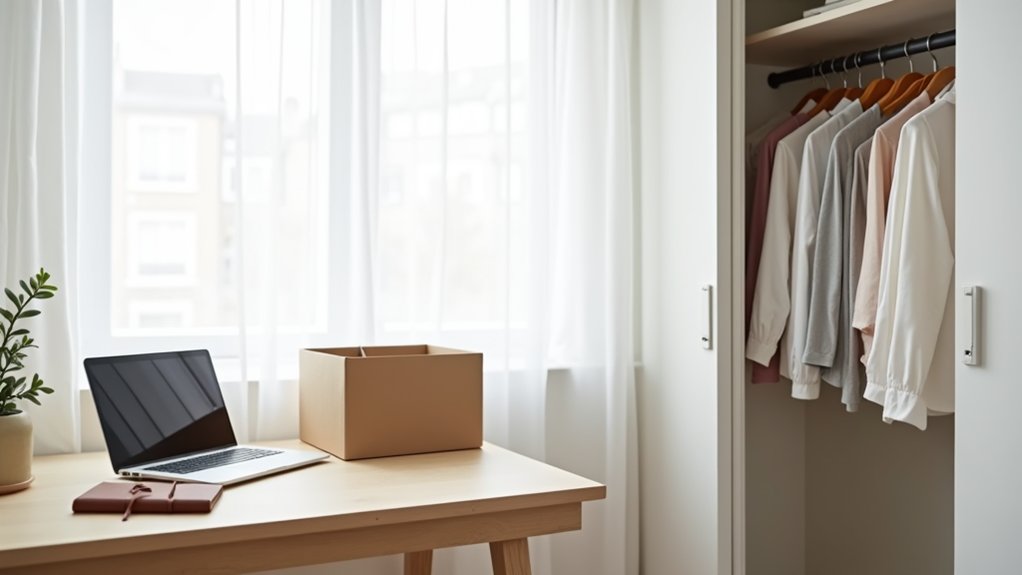Start your decluttering expedition with a manageable plan that won’t leave you feeling overwhelmed. Pick one room to tackle first, and break it down into smaller sections that you can handle in 20-minute chunks. Sort items into four simple piles: keep, donate, trash, and sell. For those tricky sentimental items, try taking photos before letting them go. Don’t forget about digital decluttering – delete unused apps and unsubscribe from those pesky emails that clog your inbox. Remember to celebrate small victories as you go, and stick to a “one-in, one-out” rule to prevent future buildup. There’s plenty more strategies waiting to change your space into a peaceful sanctuary.
Key Takeaways
- Start with one room and break it into manageable sections, using the Box & Banish method for uncertain items.
- Set specific, measurable decluttering goals and choose a method that matches your personality and available time.
- Tackle sentimental items by photographing bulky mementos and displaying only the most cherished pieces.
- Create a digital decluttering system with clear folders, regular backups, and routine cleanup of unused apps and emails.
- Develop mindful shopping habits by creating must-have lists and applying the “sleep on it” rule for non-essential purchases.
Assessing Your Current Living Space
Starting to tackle a cluttered living space can feel like scaling a mountain, but breaking down the process into manageable steps makes it far less intimidating. The key to successful space evaluation lies in taking it one room at a time – after all, you wouldn’t try to eat an entire pizza in one bite, would you?
Begin your decluttering expedition by completely clearing out a single room. Yes, that means everything! Don’t worry if your hallway temporarily looks like a yard sale gone wrong – this step is vital for proper item prioritization. Try the Box & Banish method by placing uncertain items in a dedicated box for later evaluation.
Once you’ve emptied the space, sort everything into four simple categories: keep, donate, trash, or sell. Think of it as playing matchmaker between your items and their future homes!
While sorting, be honest with yourself. That exercise machine that’s become an expensive clothes hanger? It might be time to let it go. Use practical guidelines like the 90/90 rule – if you haven’t used something in the past 90 days and won’t use it in the next 90, it’s probably time to bid it farewell.
Setting Realistic Decluttering Goals
Now that you’ve assessed your space, it’s time to chart your decluttering course with precision. Think of it as creating your personal roadmap to an organized paradise – minus the complicated origami-like folding instructions that come with furniture! Your goal prioritization should focus on breaking down big tasks into bite-sized chunks that won’t leave you feeling overwhelmed. Maintaining a clutter-free space will significantly boost your focus and creativity levels while reducing stress.
| Area | Time Needed | Items to Remove |
|---|---|---|
| Closet | 2 hours | 10-15 pieces |
| Kitchen | 1.5 hours | 5-10 items |
| Bathroom | 45 minutes | 8-12 products |
| Desk | 1 hour | 15-20 papers |
For effective progress tracking, set specific, measurable targets. Instead of saying “I’ll clean the kitchen someday,” try “I’ll sort through my tupperware on Saturday morning and keep only 10 containers.” Give yourself realistic timeframes – Rome wasn’t decluttered in a day! Schedule 15-minute daily sessions or weekend power hours that fit your lifestyle. Remember to celebrate small wins, like finally letting go of that exercise equipment you’ve been using as an expensive coat rack. Your future organized self will thank you!
Choosing Your Decluttering Method

Selecting the right decluttering method can make the difference between success and frustration in your organizational process. When it comes to method selection, you’ll want to reflect on your personality, schedule, and decluttering preferences.
Think of it like choosing a workout routine – what works for your neighbor mightn’t work for you! Having a supportive community online can provide the motivation and accountability you need to stay consistent.
- The KonMari Method is perfect if you’re ready for a total home makeover and don’t mind pulling out every single sock you own at once.
- Time-based methods like the 20-minute approach are ideal if you’re busy but want to make steady progress.
- The Four Box Method offers a straightforward system that’s great for visual organizers who need clear categories.
If you’re someone who gets overwhelmed easily, try starting with a time-based approach like decluttering for just 20 minutes daily.
On the other hand, if you’re all about dramatic changes, the Clean Sweep Method might be your style – just be prepared for some temporary chaos!
Tackling One Room at Time
With your decluttering method chosen, it’s time to put your plan into action by focusing on one room at a time. Your room selection is essential – pick the space that’s causing you the most daily stress. You know, that room where you can barely walk without tripping over something!
Start by gathering your supplies and creating a staging area for sorting. Think of it as command central for your decluttering strategy. Breaking the room into smaller sections makes the task less overwhelming – tackle that overflowing closet before moving on to the dresser that won’t close properly. Having your cleaning supplies ready will help you dust and polish as you go.
Set your timer for 15-minute chunks and plunge into it! Pull everything out and sort items into three piles: keep, donate, and toss. Be honest with yourself – if you haven’t used that exercise ball in two years, it’s probably time to let it bounce into someone else’s life.
As you work through each section, only return items you truly use and love to their designated spots.
Remember to celebrate your progress, even if it’s just successfully organizing a single drawer. Small victories add up to significant changes!
Managing Sentimental Items

Among all decluttering challenges, managing sentimental items often proves the most emotionally taxing. Let’s face it – that macaroni necklace your kindergartener made isn’t exactly high fashion, but the sentimental attachment makes it feel like pure gold.
Before diving into your treasured possessions, gather them in one spot and consider these key strategies:
- Take photos of bulky items to preserve memories digitally while freeing up space
- Start with less emotional items to build your decluttering confidence
- Ask yourself if the item truly brings joy or just guilt-induced obligation
When you’re ready to tackle those memory-filled boxes, remember that memory preservation doesn’t require keeping every physical object. That sweater from college might hold precious memories, but if it’s sitting in a box untouched, those memories aren’t serving you. Consider creating a ritual around parting with special items to provide a sense of closure.
Instead, display the items you truly cherish where you can appreciate them daily. For everything else, consider whether someone else might value it more. And don’t feel guilty about letting go – your memories live in your heart, not in your closet.
Creating New Organization Systems
Now that you’ve sorted through your sentimental items, it’s time to establish organization systems that last. Think of your home as a small company where every space has a specific role to play – just like departments working together smoothly.
Your decluttering strategies should focus on creating clear connections between different areas of your home. Start by identifying the main “departments” in your space – perhaps your kitchen is your operations hub, while your home office handles the administrative tasks.
Map out how these areas interact with each other and develop simple systems that make sense for your daily routine. You’ll want to use organizational tools like drawer dividers, labels, and storage bins to maintain order.
Just as a business needs clear roles and responsibilities, your home needs defined spaces for specific activities. Create a household “org chart” that everyone understands – maybe the kids are in charge of toy management while you oversee the command center in the kitchen.
Remember to keep it fun and flexible – the best systems are the ones you’ll actually stick to!
Digital Decluttering Essentials

Digital clutter can be just as overwhelming as physical mess, affecting both your productivity and peace of mind. Just like that junk drawer in your kitchen, your digital space can become a chaotic mess of forgotten files, unused apps, and endless notifications competing for your attention.
It’s time to adopt virtual minimalism and reclaim your digital sanity!
- Too many apps you never use? They’re like virtual dust bunnies hiding in your device’s corners.
- Thousands of unread emails haunting your inbox? Time to show them who’s boss.
- Photos so disorganized you can’t find that adorable puppy pic from last summer? Let’s fix that.
Digital organization doesn’t have to be complicated. Start by deleting unused apps and unsubscribing from those pesky marketing emails you never read anyway.
Create a simple folder system for your documents and photos, using clear names that’ll make sense even when you’re having a rough Monday. Back up your important files to the cloud, and don’t forget to regularly empty that digital trash bin.
Maintaining Your Clutter-Free Environment
Having invested time and energy in decluttering your space, maintaining those hard-earned results becomes your next essential challenge.
Think of it like keeping a garden – without regular care, the weeds (or in this case, clutter) will creep back in!
Start by establishing daily routines that’ll make tidying feel less like a chore.
Wash those dishes right after meals, put clothes away when you change, and spend just five minutes clearing flat surfaces before bed. You’ll thank yourself tomorrow!
Household involvement is key to long-term success.
Turn organization into a team sport by assigning specific tasks to family members. Maybe your partner handles the mail sorting while the kids tackle their toy zones.
Don’t forget to celebrate small wins together – even a consistently clear kitchen counter deserves a high-five!
Make smart storage your best friend.
Label everything (seriously, everything!), use vertical space wisely, and remember the golden rule: every item needs a home.
When you bring something new in, say goodbye to something old. It’s like a one-in, one-out dance party for your stuff!
Mindful Shopping Moving Forward

Mindful shopping serves as your next powerful tool in maintaining a clutter-free life. By making intentional spending decisions, you’ll avoid filling your newly organized space with items that don’t serve a purpose.
Think of it as putting a security guard at the door of your home – but instead of checking IDs, they’re checking if each purchase truly deserves a spot in your life!
- Create a must-have shopping list and stick to it like your favorite playlist
- Research brands that align with your values (because your money talks!)
- Practice the “sleep on it” rule for non-essential purchases
When you’re making mindful purchases, focus on quality over quantity. It’s better to have one fantastic sweater that lasts for years than five cheap ones that pill after two washes.
Before reaching for your wallet, ask yourself if the item will truly enhance your life or if it’s just a temporary mood lift. Remember, you’re not just buying things – you’re investing in your clutter-free future!
Building Long-Term Decluttering Habits
Now that you’ve conquered mindful shopping, let’s turn those decluttering wins into lasting habits that stick. The secret to lasting change isn’t about dramatic purges – it’s about small, consistent actions that become second nature. Think of habit formation like training a puppy: it takes patience, consistency, and plenty of positive reinforcement!
| Time of Day | Decluttering Action |
|---|---|
| Morning | Make your bed & clear nightstand |
| After Meals | Immediate dish cleanup & wipe counters |
| Evening | 10-minute room reset |
| Before Bed | Layout tomorrow’s essentials |
Breaking emotional attachment to items becomes easier when you create simple daily routines. Start by picking one small area – maybe that counter that seems to attract clutter like a magnet – and spend just five minutes each day maintaining it. You’ll be amazed how these tiny actions snowball into bigger changes!
Share On X
Conclusion
You’ve survived the decluttering marathon, and your space looks absolutely incredible! It’s like you’ve changed your home from a chaotic jungle into a peaceful zen garden. While you might occasionally slip back into old habits (we’re all human!), you’ve now got the tools to tackle any clutter crisis. Remember, maintaining your clutter-free paradise isn’t about being perfect – it’s about making better choices every day. Your future self will thank you!
Join our list
Subscribe to our mailing list and get interesting stuff and updates to your email inbox.

